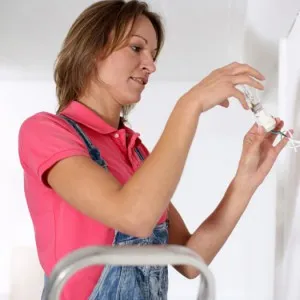Is your garage lacking power? Sometimes we could all do with an extra outlet or two, whether it’s to help us see what we’re doing, install a garage door opener, or for those home DIY projects.
Today we’re going to show you exactly how you can rewire your garage. The process is simpler than you might think, but it still requires skill and attention to detail.
In a Nutshell
This article is going to go over the basics of how to extend PVC conduit from an outlet in order to add more outlets and/or a hanging fixture over your workbench area.
NOTE: It’s worth bearing in mind that your existing wiring might not be adequate for running larger power tools or power guzzling appliances such as tumble dryers or freezers.

Plan and Set up Your Outlets
First thing’s first: it’s best do a quick sketch of your garage’s layout to help determine exactly how many outlets and light fixtures you’re going to need.
WARNING: If working on this yourself, make sure the power is off before you do any work on the wiring. Hold a non-contact voltage tester next to each wire to check.
According to familyhandyman.com, you should begin by carefully planning out your wiring scheme and nailing up all the electrical boxes you’re going to require.
The article says: “To run a cable from one box to another, pull cable off the coil, strip at least 8 in. of sheathing off the wires and thread the wires and about 1/2 in. of sheathing through the wire opening in the box. Untwist the cable and staple it at least every 4 ft. to the framing, all the way to the next box without cutting it to length.”
For a detailed, step-by-step guide, take a look at this useful article: ‘How to Wire a Garage (Unfinished)’. This should give you a very good idea of the work involved, and help you determine whether you should hire a certified electrician for the job.
Remember, you should staple your cable every 48 in. between your boxes, but preferably more. Your cables should be tight, with no sagging.
Run the PVC Conduit
Surface cables on hard-surface walls should be protected using PVC conduit, as mentioned above. PVC conduit is the preferred choice, as it’s so much easier to cut and work with, not to mention versatile.
Familyhandyman.com says: “At home centers, you’ll find a variety of PVC fittings that let you turn corners and run the conduit exactly where you want it; no need to learn the art of bending conduit as there would be with metal.”
Consider Hiring a Professional
The DIY home improvement site familyhandyman.com offers this caution: “If you have aluminum wiring, don’t work on it yourself. The connections require special techniques. Call in a licensed electrician who is certified to work with it.”
The basics of adding circuits to your circuit panel are explained in this eHow video, which also highly recommends hiring a licensed and certified electrician to help you.
Are You Rewiring to Prepare for a New Garage Door?
Whether you are planning to install a new garage door, or you’re considering it now that we mentioned it, you’ll need to be aware of your electrical needs.
At Garaga, we know what kinds of challenges homeowners face when trying to set up a new garage door. Contact us with any questions you might have, or if you’re interested in learning more about our residential garage doors.

Add new comment